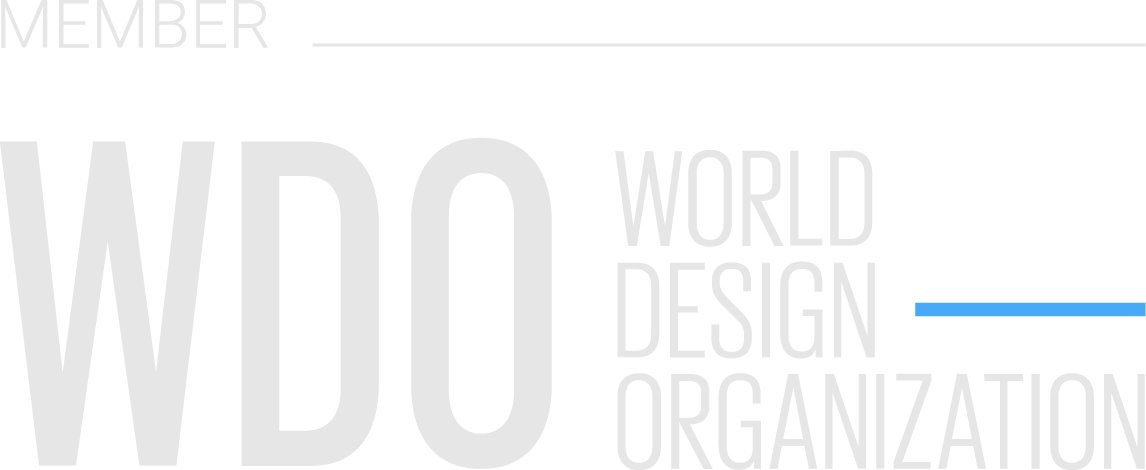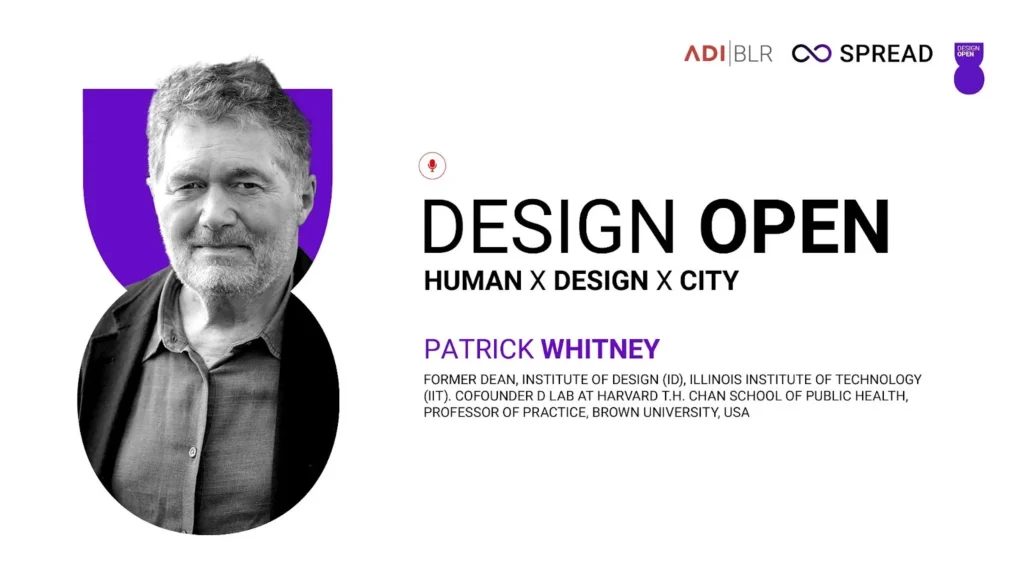
HUMAN X DESIGN X CITY
Industry leaders, policymakers, and educationists are the new design enthusiasts who are beginning to understand the value of design as a discipline and its capacity to bridge knowledge and action. They are learning about the various ways design can help their teams think holistically, consider radical new approaches, respond to complex scenarios, new challenges and realize positive change.
In turn, this emerging demand presents designers with a new set of challenges and responsibilities, to expand their ways of creating value, engage with a broader range of stakeholders, and catalyze a deep understanding of complexity that’s currently increasing barriers to creative action.
Design Open invited Patrick Whitney, one of the fathers of human centered design and strategic design for a two-part activity, including an invite-only conversation and evening and a talk, open to the public. Combined, these engagements created a unique opportunity to bring together brilliant minds around Bangalore.
Bangalore is a city that is growing at an alarming rate. The conversations were curated around the impact of the multiplier effect of a rapidly increasing immigrant population, the ever-diversifying patterns of everyday activities that create a new context, stressing the importance of adopting more pliant approaches to destress infrastructural interventions. For designing a dynamic city with humans at the heart of change, to make Bangalore a progressive city leading sustainable development.
Given Bangalore’s leanings as a creative and knowledge city, there was enthusiastic participation at both events and great interest in taking forward ideas into action. Spread Design and Innovation was honored to host Professor Patrick Whitney at Design Barn, Bengaluru, on 13th and 14th March 2024 for a Design Night and a Design Open. Professor Patrick Whitney is former Dean of the Institute of Design (ID) at the Illinois Institute of Technology (IIT) Chicago, Cofounder D Lab at Harvard T.H. Chan School of Public Health, professor of practice, Brown University, USA. He was recently bestowed with an honorary Doctorate by the Transdisciplinary University, Bangalore.
Industry + Education Leaders.Young professionals. Students. Old and New residents of the city.
The conversations with Prof Whitney were a mind and eye opener. Read further to immerse in the reflections and insights. Also find links to the video recordings.
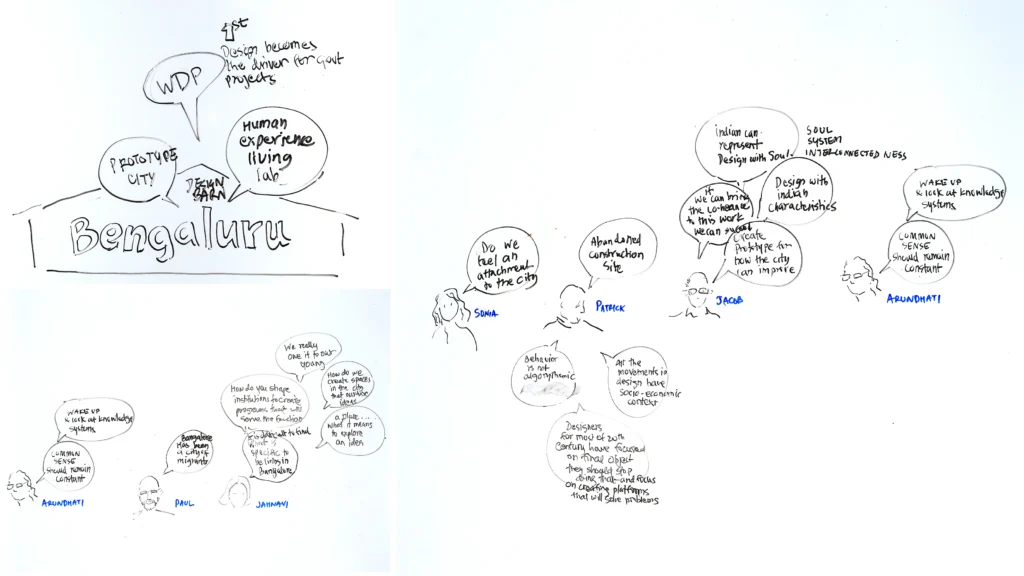
DESIGN NIGHT
A fabulous night of conversations between Arundhati Nag, Jacob Mathew, Jahnavi Phalkey, Paul Fernandes and Patrick Whitney. With an audience composed of industry and creative leaders.
Ms. Arundhati Nag is a veteran Indian film and theater actor and driving force behind Ranga Shankara, an iconic destination for theater in Bangalore.
Ms. Jahnavi Phalkey is a filmmaker and historian of science and technology, and the Founding Director of Science Gallery Bengaluru and Sir Ashutosh Mukherjee Visiting Professor at the National Institute of Advanced Studies.
Ms. Sonia Manchanda is an elected Board Member of the World Design Organisation, Founding Partner at Spread Design and Innovation, creator of the Design Barn and Design Open.
Mr Jacob Mathew, president of Association of Designers of India (ADI) is senior Design Principal at the Srishti Manipal Institute of Art, Design and Technology, Bangalore, and one of the pillars of the World Design Protopolis (WDP) Project.
Mr Paul Fernandes, beloved Artist of the City, is the creator of cartoons, illustrations, a chronicler of time and a master of the art of storytelling.
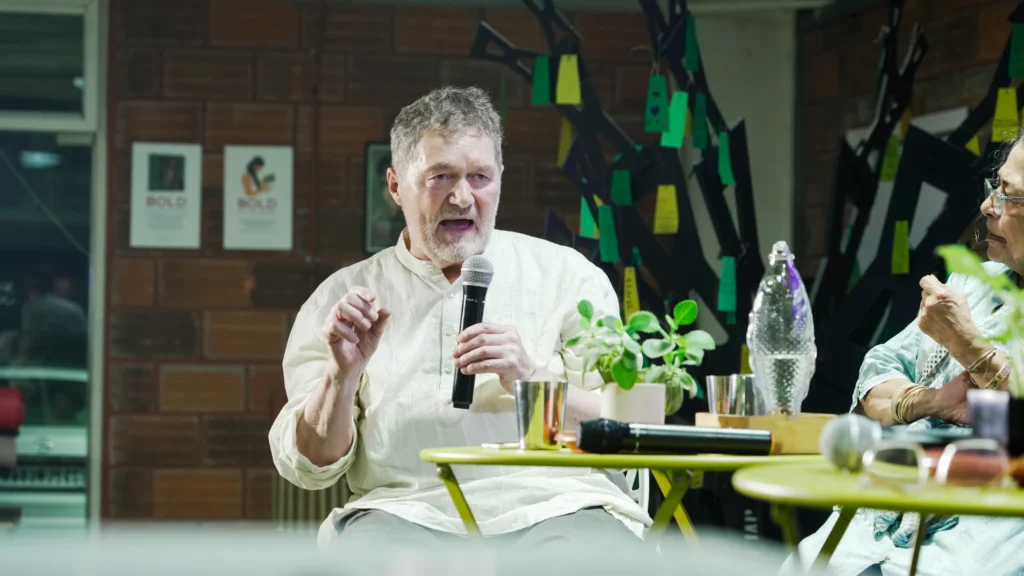
Sonia Manchanda launched the conversation with the fact that Bangalore in the last three decades at least, has been a city in transition, a prototype city. A schizophrenic city that, for those facing the challenges of a changing city, this ‘Human Experience Living Lab’ can feel like hell. In this petri dish, where different cultures thrive, can design there be a catalyst? To make sense of change.
To her provocation around how we might inspire a sense of belonging among everyone who comes to Bangalore, to make the city more livable; Paul Fernandes, the artist, responded highlighting the fact that Bangalore was always a city that had people coming in across the ages.
Bangalore has always been a city of migrants, right from the beginnings of the Hoysala empire, when people came here with ideas, settled down and ruled Bangalore for hundreds of years. Another migrant was Kempedgowda who did something so constant for us – he founded Bangalore. Other migrants that followed him, the Marathas, the Mughals, the Mysore Maharajas, the Wodeyars from Mysore, Hyder Ali, Tipu Sultan, 200 years of the British Raj and they all gave us so much. All of them gave us “design” in their own way which we employ today (including the types of trees we see in Bangalore today). That’s been a huge constant. Post independence, Bangalore had pensioners as migrants, who lived a wonderful life in Bangalore for decades. The city started growing, millions came to live and work. The city had a beautiful, charming and powerful voice and the city loved to listen to that voice. Towards the end of the century, Bangalore welcomed another migrant, the IT industry with the pub industry. The voice of the people started getting louder. Today in 2024, the voice of the people is powerful and strident. But maybe the city is losing her voice.
Jacob Mathew elaborated the fact that while Italy is about style, Germany is about durable design, Switzerland is about precision and Japan is known for new technologies, India is about design with soul. In the Indian tradition, each of us is God. We are part of God and we are interconnected. It is Soul, System, and interconnectedness that creates new solutions.
Arundhati Nag added that common sense needs to remain constant. In our chase for design per se just as a kind of visual material we really give a vacation to common sense. It is now time to wake up and look at knowledge systems which work for the planet.
Jahnavi Phalkey shared the need for a public space that to some extent returns the joy of what it means to explore an idea or an experience. That we collectively owe it to the next generation to create a nurturing environment for the young adults so that they can find the resources and strength to access something new, to meet new people, to talk to someone who is not doing something different.
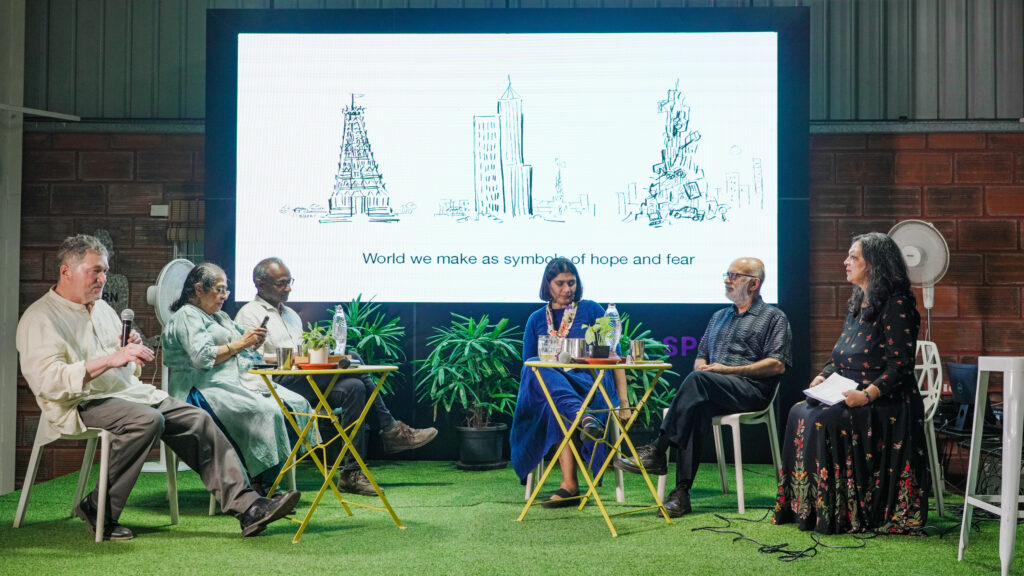
Patrick reminded us that there is ‘no away’. We shut our eyes to things that are ugly and pretend that they don’t exist. His radical thought (and visual representation) is – what if we were to make the ugly stuff visible? If religious towers of yore, which have been replaced by financial towers of the present…were to be replaced in the future, with garbage towers – making the problem visible, we would no longer hide from it and actually act around it. He is dead serious about this.
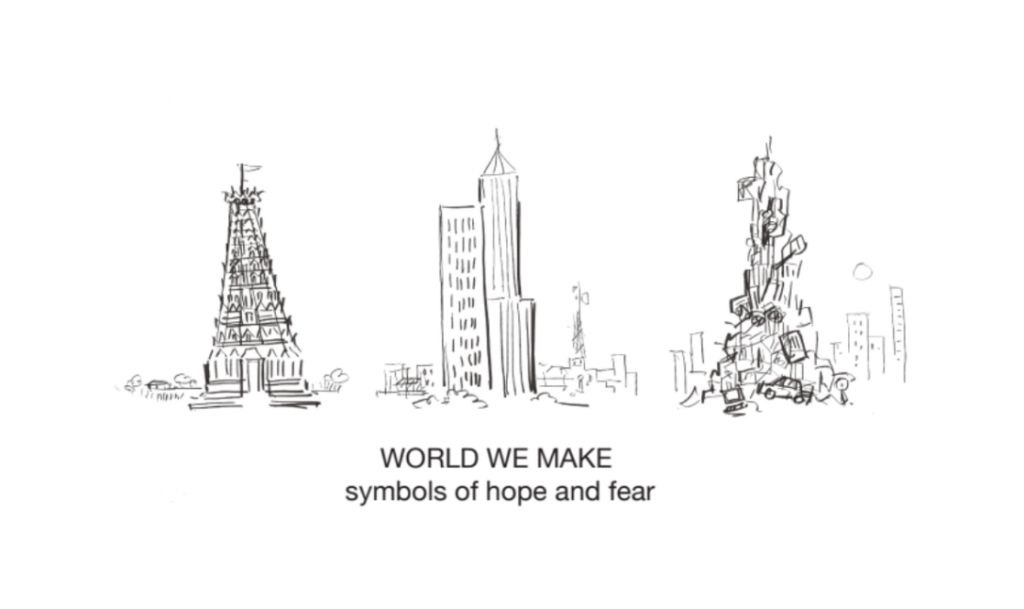
Similarly, for the water problem, if water levels of the city were visible, we would fight to keep the levels up. We can and should no more live in a bubble of our own imagined city, but have the nerve to look problems boldly in the face first!
In his view, it is a defining moment for India, where we have to decide whether we want to follow western footsteps or given the pitfalls of those models, make our own path that is far more humanistic, holistic, open and adaptive.
While the conversation flowed on stage, Mr Sameer Tendolkar from LEAP illustrated the insights live on the big white board at the Design Barn.
As the evening unfolded, the audience eagerly immersed themselves in the dialogue, their curiosity sparking a flurry of questions that filled the air, creating a vibrant exchange of ideas and insights. City leaders were deeply involved in conversations about design at the scale of cities and for the purpose of big change.
Design Night was a riveting conversation between creative leaders who, deservedly, feel a sense of ownership for this youthful and vibrant city. Pointing out that it has always been a city of immigrants, rulers and leaders. Interestingly, each left a positive mark on Bangalore. Making it what it is, pointing the way for what it can be. In this scenario thus, the city must not resist the new citizens but be especially welcoming and sensitive if that’s what should be expected of them – to be sensitive to the city.
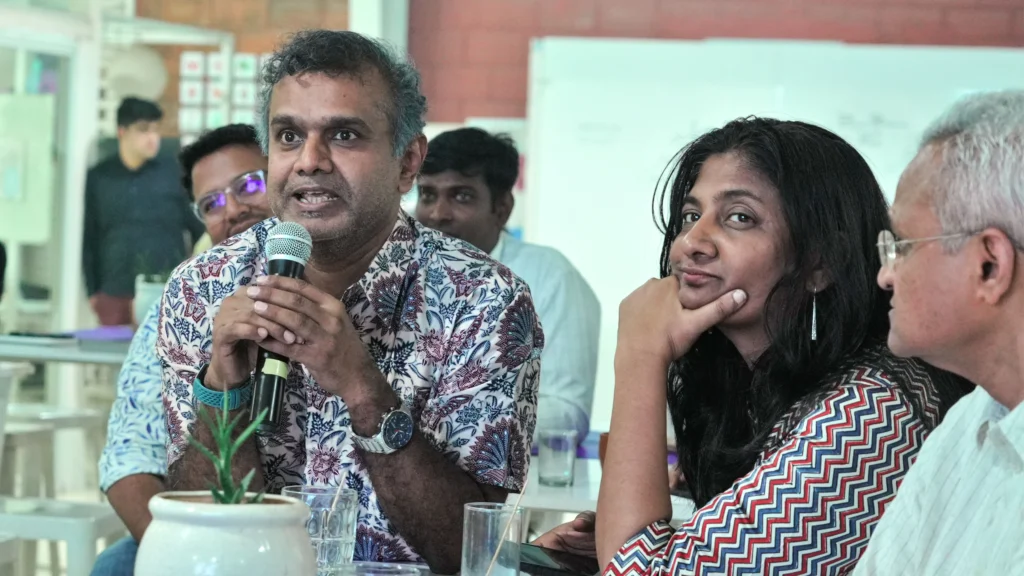
Question Hour
Q: How do you see the people of Bangalore change since the days of Auto Raja and Malgudi Days?
Ms. Arundhati Nag: Back in the day you did not have so much immigrant population in Bangalore. You had many immigrants from Karnataka coming to Bangalore. Today it needs a different heart to endear the new immigrant. There are people who have come here for a livelihood. It is the task of old residents to make the newcomers feel comfortable and welcome. The question of contribution to Bangalore comes after a sense of ownership and that takes time.
Q: If we increase the diversity in groups, for example designers, engineers, architects coming together, would it improve our future or cause more problems?
Ms. Jahnavi Phalkey: Differences show up when you unravel each other’s minds but that’s a good thing because a fossilized mind is not a good place to feel alive. It’s a shrunken imagination where urban planners don’t understand people’s way of using water, ways of organizing their lives. When people from various disciplines come together that’s where the magic happens.
Q: How important is culture when you look at the design for a city to be futuristic and this cultural trade of constant reinvention and being with the time?
Professor Patrick Whitney : Culture is the difference between thinking of doing something and what is normally done. By the time you figure out what Bangalore is, Bangalore will change. It’s a constantly moving target.
Ms. Arundhati Nag: Culture is really what you do after you close the bedroom door when nobody is watching. It is surreptitiously flowing under your skin, under the surface of the garbage city that we are becoming. It is up to us to seize the moment, nurture it and make it into a bigger moment for all of us.
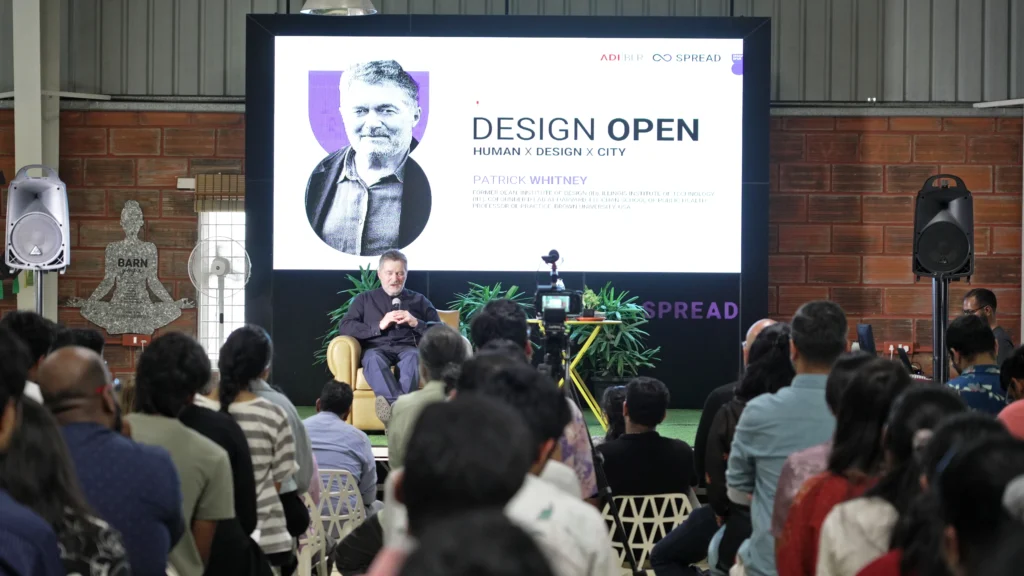
Design Open: Talk by Patrick Whitney
On 14th March 2024, Spread and Association of Designers of India (ADI) together hosted a Design Open with Professor Patrick Whitney at the Design Barn.
An eclectic mix of over a hundred citizens of Bengaluru assembled at the Design Barn for the session. It was a packed house with students, design educators, design practitioners, entrepreneurs, authors, chief design officers, artists, architects et al.
The Design Open started with Ms Sonia Manchanda connecting the dots between Carlos Teixeira, her friend and collaborator from USA and Brazil, to Andre Noguiera, a next generation leader and finally Patrick Whitney and the network across the small world of strategic designers. Bridging knowledge and practice, thinking about frameworks while working in the field to enable connections and a wider understanding and application of design.
Next, Mr. Sameer Tendolkar from LEAP introduced Professor Whitney and the transformational work that he is doing in the State of Jharkhand, India.
Patrick Whitney is the former Dean of the Institute of Design (ID), Illinois Institute of Technology (IIT) where he was the Steelcase / Robert C. Pew Professor of Design and a distinguished IIT Professor. During his leadership of ID the school created the first PhD program in design in the USA, transformed ID, into a leading institution in design methods and theory, and created an executive education program translating design methods and theory. He was also awarded the Lifetime Achievement Award from the Hong Kong Design Centre for bringing human-centered design and strategic design to Asia. Forbes named him as one of the 6 members of the E-Gang (people reinventing rules of business, customer by customer) for his work in human-centered design.
Insights from Design Open
Taking the centrestage in the packed Barn with 100+ participants as we also began the Livestream of the event, Prof Whitney opened the discussion with the thought that it’s hard to think of a city where design has played a strong role and discomforting as it may sound to designers and innovators in the Barn, the discussion was to disrupt linear thinking and burst the imaginary design bubble which is just data driven and ignorant of ambiguous information -the unpredictable patterns of human behavior.
Some books he mentioned while talking about this were, Design Of Everyday Things by Don Norman and Plans and Situated Actions by Lucy Suchman.
Discomfort and Disruption / Breaking Patterns
Like the preceding session at Design where he mentioned his first impression of Bangalore today as looking like a construction site, the much needed discomfort to shake things up, stir up active thinking was continued with him saying, “leaders of big projects want to know how much of an increase of traffic there’s going to be and is it going to be what they are predicting or they are going to have to change their predictions. The problem is most systems look for certainty and when they find information that is ambiguous, they leave it out and they keep leaving it out until they can get to a certain answer, there’s a pile of unknowns on one side and a small amount of certainty on the other.”
He disrupted the 20th century industrial hangover by pointing out the dearth of evolution in the design field.
“Designers have not gotten farther than making keyboards that are easier to use.”
This was justified with a clear recall that the 20th century created Marketing and Public Relations and Design to cope with mass production, mass markets and mass media. The breakthrough of human centered design in the 1980’s were to make keyboards ergonomic, information on screens more understandable, controls on cockpits of airplanes and dashboards of cars, understandable.
Behavioral Systems Vs Algorithmic Systems
Professor Whitney would like us to think of how many of our pressing challenges are characterized by a misfit between algorithmic and behavioral systems. Algorithmic systems are highly predictable as they rely on current information and deep knowledge. Behavioral systems are highly unpredictable as they are influenced by emotion, culture, and context. Overcoming complex public challenges demands integrating knowledge from disciplines that evolved to work within and across these systems.
If the opening insights were strong the questions from the audience were smart, deep diving into the future, seeking possible solutions, churning out more insights.
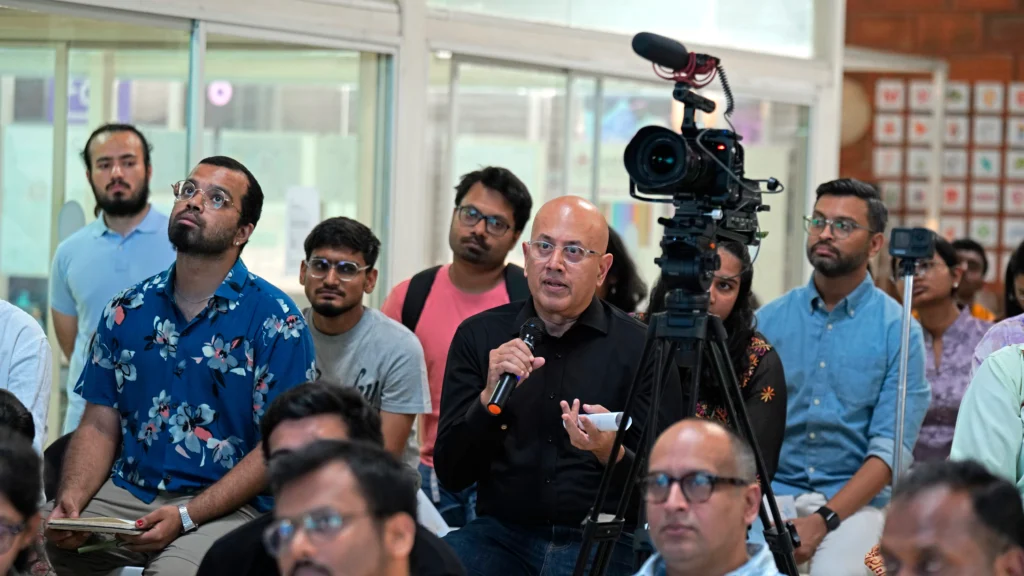
One such question was:
Circular Economy and Circular Systems are the way ahead. I think we have become a very service oriented economy. Almost every product is a method to sell a service. What’s your take on altering / defining Behavioural Systems?
To this, Prof Whitney did mention that services are on the rise, often defining the element of a product. That we know only how to manipulate 5 or 6 things in an overall offering – People, Sales Staff, Repair Staff, Objects, Environments, Messages, Services. But now we need to think about how they work together as a system and not define ourselves as object designers or as Environmental Designers.
The idea now is these things have to be connected. He explained this with the POEMS model – People, Objects, Environments, Messages and Services and how he got executives to describe the POEMS, the elements of POEMS they have produced and how they relate to each other. That’s a conversation the executives in the world of design or products, never had before.
After emphasizing on POEMS (a component of the Whole View Model) Prof Whitney also described to us the Model which is centered around the idea of Why Do We Want to Make It (a product/ service). The synergies that need to be found with essential questions like What Business Are We In, Who Is It For, What is the World We Want to Make? Why Does it Create Value?
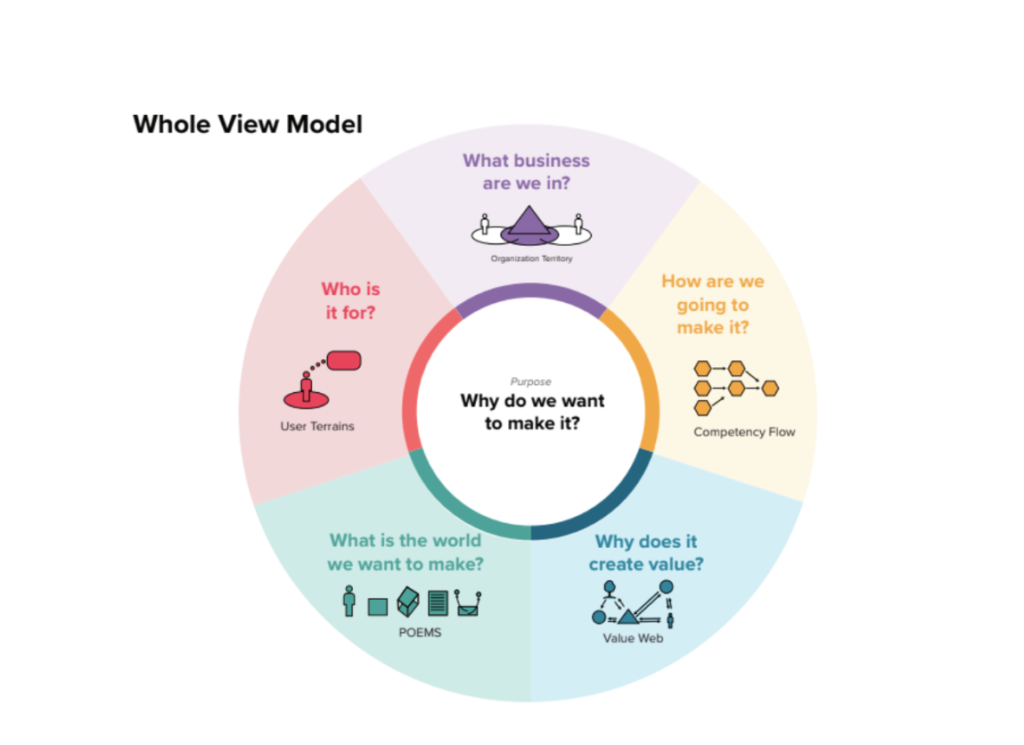
While the audience held on to this revelation, the next trigger for Prof Whitney from one participant was –
The whole idea of designers being anti consumerist in itself is quite rebellious for a country like India at this point, where jobs are one of the major criteria or parents choosing one school over the other. The whole idea of how this approach of a problem solving anti consumerist designer is not very understandable for the masses. This coming full circle, that buying more is not the solution is a long way for a country like India. Do you believe that it’s possible for people to not have gone through the cycle of consumption and yet to realize what is the damage and what is the environmental cost?
Prof Whitney gave the example of China and the United States where consumerism was not the origins of the industrial culture and worldwide although the investment in advertising is to make people indulge more with consuming than creating stuff, the natural inclination of humans is more towards creating than consuming.
He gave the example of children, who if asked to choose between a book with blank pages and coloured pencils and a book which has pictures in it, would naturally choose the one with blank pages and colour pencils.
“Making services is also something people like to do, to help each other, that’s not everyone but most of us.”
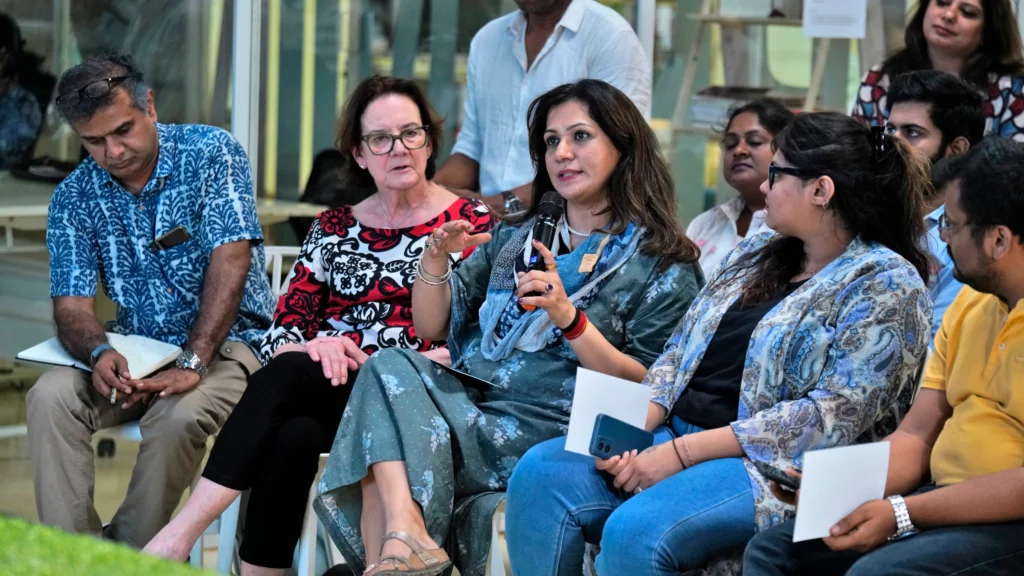
On another note, Professor Whitney highlighted the need for designers to reflect deeply upon everything they do. Talking about the “Reflection Deficit Disorder” and how each one of us has the ability to cure ourselves of it. Creating a shift, where work becomes reflective and learning is productive.
Bangalore Then & Now
Design Barn was and still is, dressed in artworks from Bangalore Then and Now, an exhibition by Artist of the City and renowned cartoonist, Paul Fernandes. This exhibition is an extension of Paul’s new book “The Great Bangalore Morph: From Kempegowda to Covid”. The creative energy this brings and exudes from the Design Barn is palpable. You must come over and experience it!
Guided by the Artist of the City, audiences from diverse age groups and geographies went on an exciting journey of our changing Garden City across the ages, from the days of yore to more familiar times to 2019, the year the world changed.
The exhibition is divided into 3 zones
Zone 1 at ground level/ lobby at Design Barn
Introduction to Bangalore’s Past – which had popular artworks like How Bangalore Got Its Name, Return to the Wodeyars, The British Cantonment, Post Independence
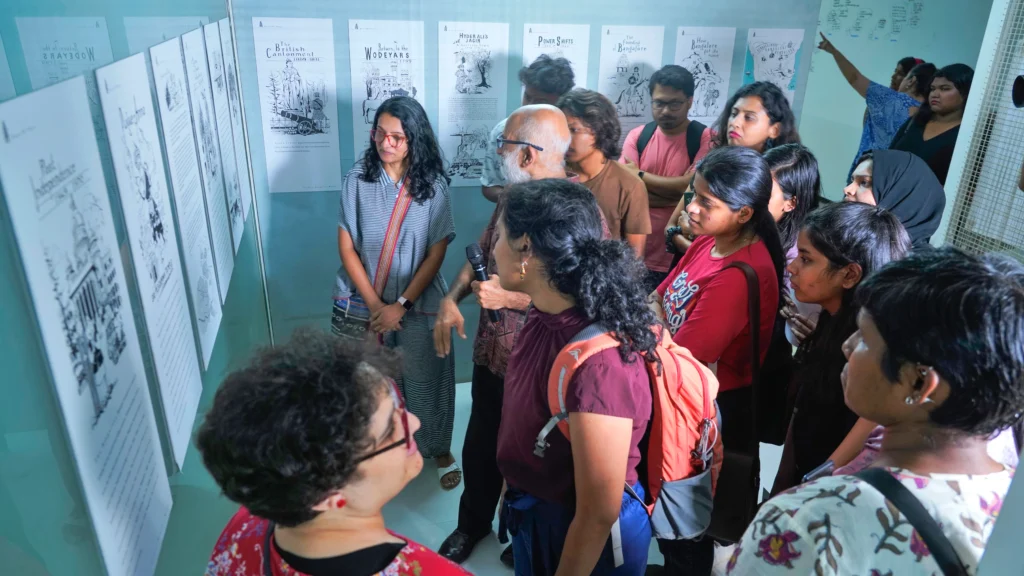
Zone 2 at ground level/ Lobby at Design Barn
More Familiar Times – which reflects transformation of size, scale and nature of Bangalore (through IT Park, Cubbon Park, Biotech Park, Mysore Park and more)
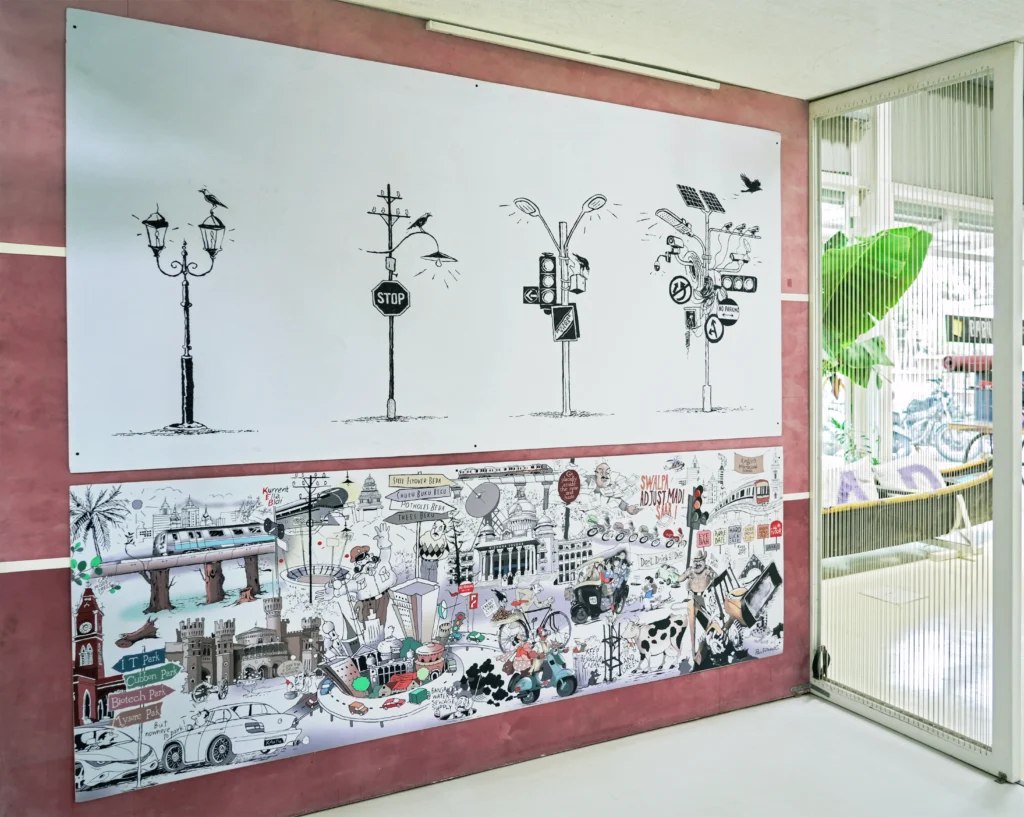
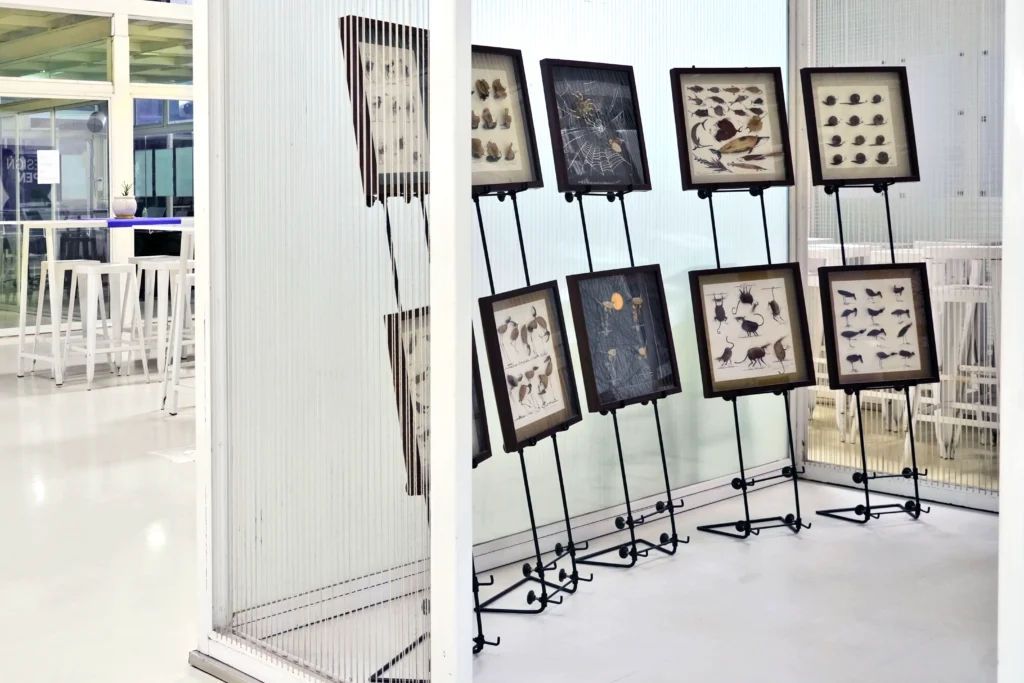
Zone 3
City Avatars with artworks like Pensioner’s Paradise, Garden City, Pub City, Silly Con City, Boom City and 2019 The Year Our World Changed
The exhibition is still ongoing at Design Barn for those who want to visit and experience Bangalore Then & Now
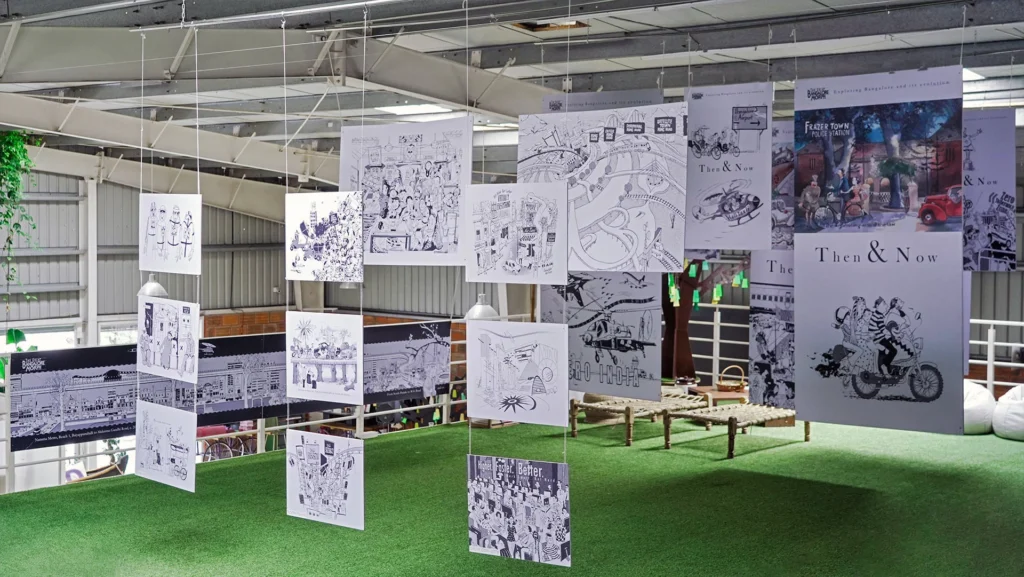
Purchase your copy of The Great Bangalore Morph here:
https://apaulogy.com/shop/coffee-table-books/the-great-bangalore-morph/
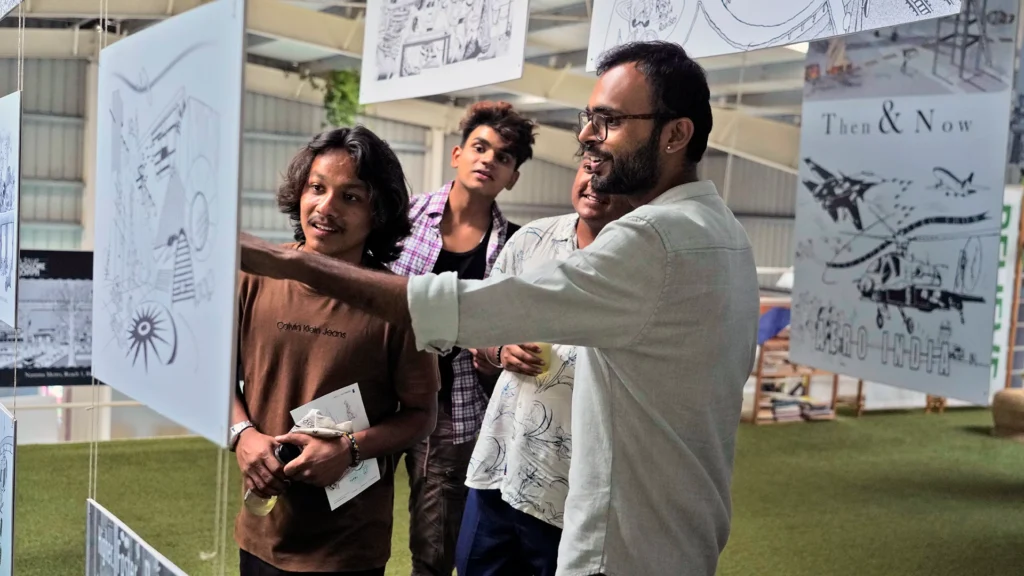
Food, Fun & Conversations
The bonhomies flowed with treats that the Design Barn sensitively puts out like
Blossom Litchi Soda, Dahi Pakodi Chaat, Amritsari Chole and Murgh Makhanwala to Stuffed Amritsari Kulcha, Kullad Murgh Biryani and Angoori Rasmalai Shots coupled with drinks like Classic Mojito and Bellini. The larger participation at Design Open enjoyed Barn specials like the Veg Sliders, Basil Lemonade and Cookies.
Conversations flowed on both days along with good food, networking and idea boards where many participants shared their strategic ideas for making Bangalore liveable.
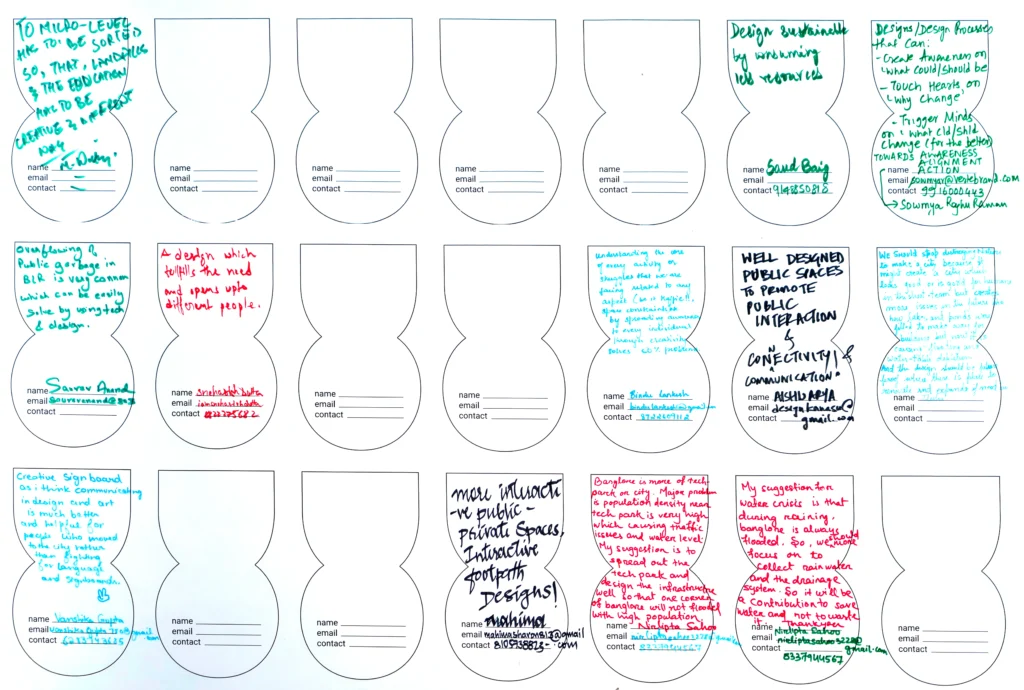
Moments in between such conversations throw up fresh insights and help us all reboot, admitting that we each might be stuck in a place of thinking and it helps to connect, communicate and create convivial spaces to progress thought and action.
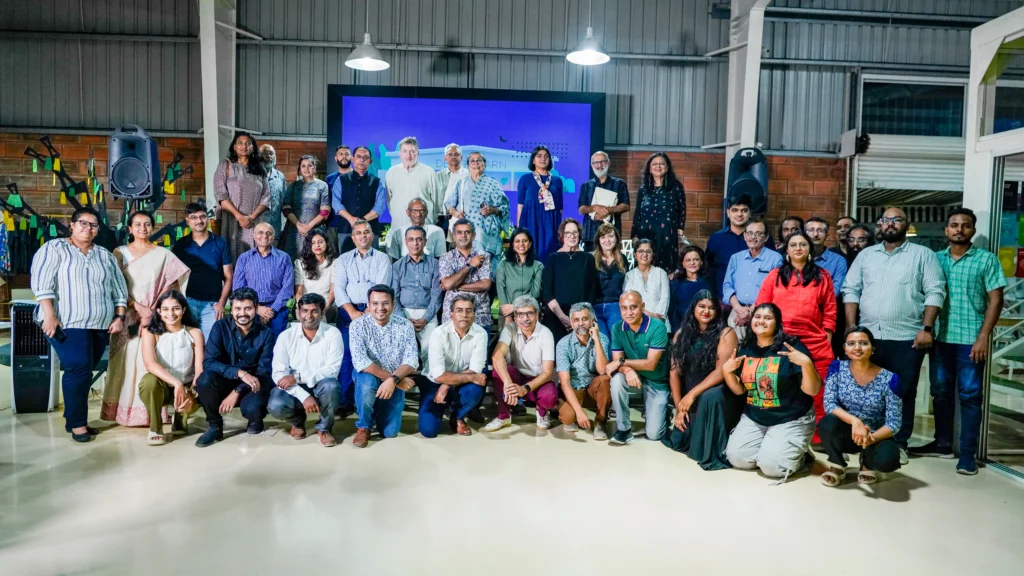
Creating a bridge between academia and practice, a moment for reflection to shift mindsets around important issues, question our role, capacity and individual agency, think about the new systems and platforms we need to build and take responsibility. Design Open expands possibilities for co creating a better city, a wetter world.
Design Open is a property of Spread Design and Innovation. It’s a platform Design Open is a platform for conversations with leaders working at the forefront of DICE. Carefully curated, futuristic and deeply engaging. A watering hole to soak up fresh insights. With talks, hands on workshops and studios to immerse in design knowledge, methods and tools.
